When it comes to publicity, the first thing that comes to mind is share on LinkedIn or post a WeChat moment. You may also want to persuade media outlets to help you share the news. In this case, a press release is needed.
Press releases may sound old-fashioned but it’s an effective way to communicate with your target audience if the content is properly tailored. While some corporates may think press release is a one-way communication where you “push” your message, it can be a vehicle to build a meaningful dialogue with our readers.
Set your communication goal
It is important to set your goal and identify your target audience before sitting down to write. This helps determine angle, tone and detail. For example, a B2B company launching a new product with the goal to boost sales. In this case, the target audience of the press release can be trade publications (to reach potential customers) with the angle skewed towards the product features and key selling points. If the goal is to reach out to investors for future fund-raising, the release must include key commercial milestone supported by detail on future plans and business developments for the coming year.
It is not a monologue
It takes two to tango. A good press release is about connecting with your target audience. Before blowing the trumpet about how great your company is, put yourself into your ideal reader’s shoes. Find out what they care about and build a link as to how your company (or your product) can help. Simple, jargon-free, relatable language builds a bridge. If you need to use specific terms, try to explain them in plain language. Always spell in full before using abbreviations.
Keep it short and concise
Be selective. A good press release should always be short and sweet. Readers have short attention spans. Journalists and editors are busy and may be covering multiple beats with little expertise in your sector. Reputable media (and social media) welcome brevity and a concise message. Spare them from hunting for the key information in your long-winding essay. Develop your press release in the “inverted pyramid” format, start with your key message followed by examples, context and supporting points.
Put things into perspectives
Help readers to visualise the issue by providing context. Facts, figures and examples are good reference points when making a statement - comparative growth figures, market benchmarks all help build context. If you want to say you have happy clients, put in a client testimonial to back it up. It will serve as a strong third-party endorsement. Similarly, if you are going to use a quote from someone in your company, an investor or a company - use it. Too many quotes fall back on vague pleasantries and formula - this is your chance to inject personality in to the content.
Maybe provide a picture too
Humans are visual beings. And media outlets, particularly trade and financial are often low on photographs and illustrations. A good photo can help propel your story to a more prominent position.
Leave a contact
A press release is a teaser for further communications between your company and your target audience. Journalists may also need to reach out for further information. Be sure to include the boilerplate and website of your company and your contact details.
Last but not least…
Follow up
Media outlets receive hundreds of press releases every day. After you send out yours, make sure you call and follow up. It will maximise the chance of having it published.

